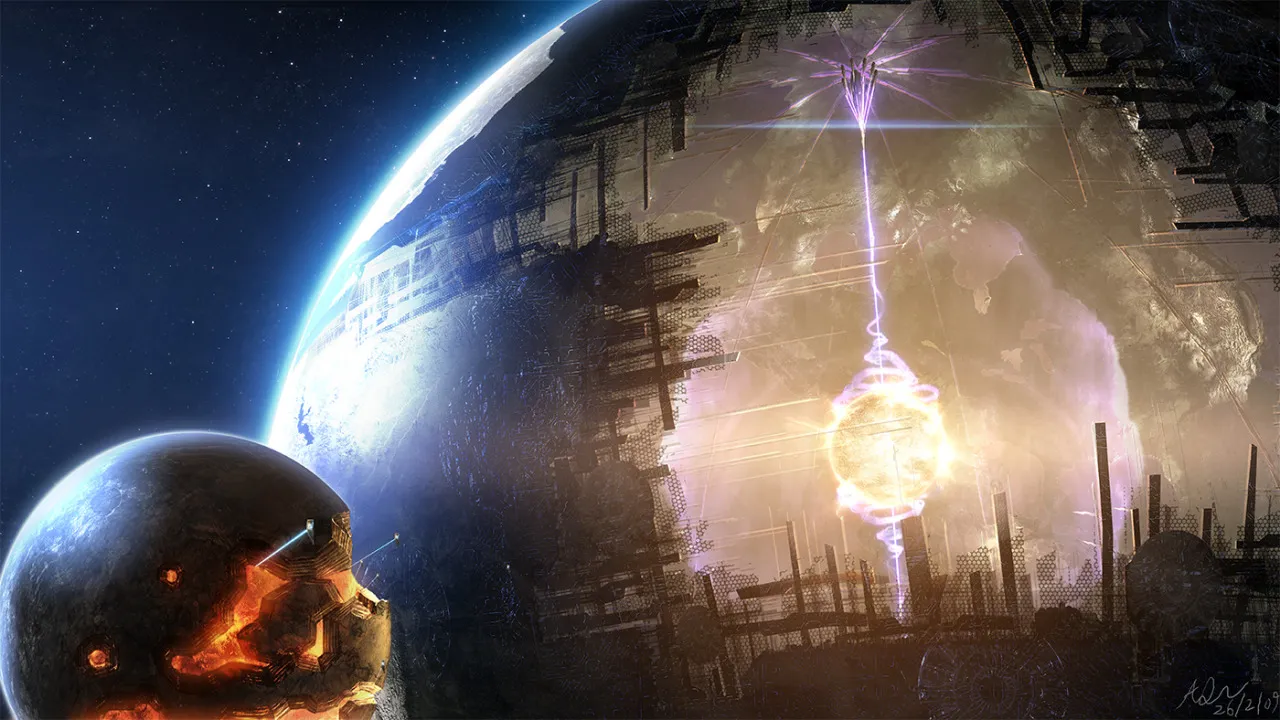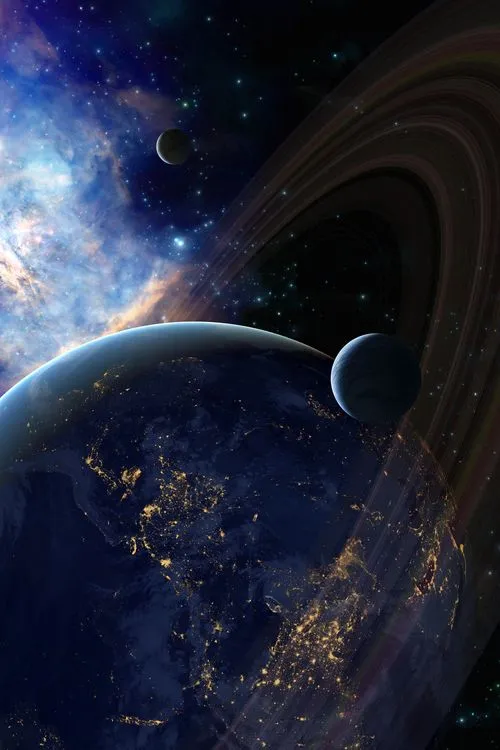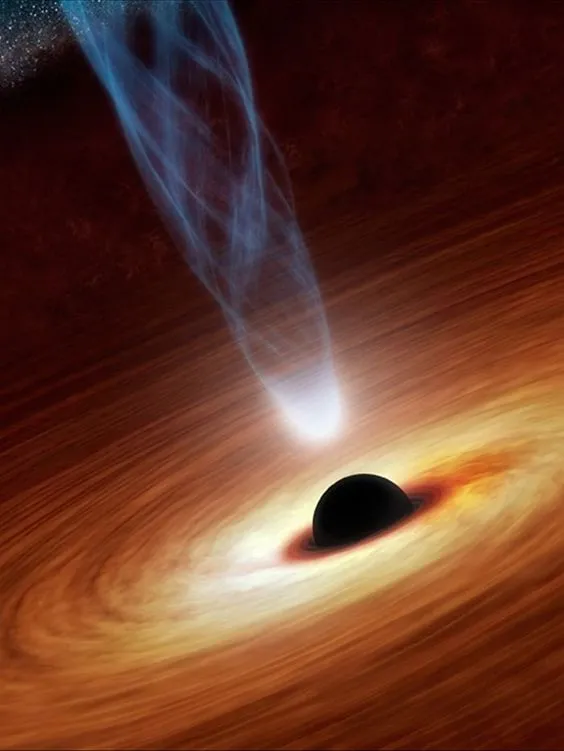Advanced Civilization
Editor
IG. @BlueDDS - Dr. Hardy
We live in a conflicted society despite the cultural and technological advancements occurring through each generation. It's the most accepting and open-minded society to date, yet some still feel confined by what society defines as the "norm." Not everyone can be satisfied, but changes should aim to encompass the benefit of the majority of global stakeholders.
And a step further to understanding better one another may resolve to better functioning society in general.
More safer, collaborative, understanding, basically an utopia world, with the freedom that anyone can experience.

(Dyson Sphere)Phot Cred:
@mirko
-LUXÆTΞɌƝΔ-
The Civilization We Currently Live In
Will we remain a Type zero civilization, or will we advance and make our way into the stars?
Type zero - the current state, advancement that we are now. The amount of power that current civilization has the availability. Type zero civilization is a subglobal civilization.
Based on our energy use, in 1973 astronomer Carl Sagan estimated that Earth represented a Type 0.7 civilization. Now the current astronomers have estimated we are in 0.72. In 4.5 billion years, we still haven’t reached the Type one civilization.
The Kardashev Scale Explained
Below you can see the graph of how the Kardashev scaled is measured.

Cred: https://worldbuilding.stackexchange.com/a/13656
According to Michio Kaku we have reached the point in society where the next century will determine if we will advance and learn how to cooperate with one another or disappear from the face of earth.
We currently are in a type zero civilization. There are five types all together, which originally was measured in Kardashev scale (will go in detail below).
@michiokaku
Experts assert that when civilization grows larger and becomes more advanced, its energy demands will increase exponentially due to rising population growth and the energy requirements of constantly improving machines.
With this in mind, the Kardashev scale was developed as a way of measuring a civilization’s technological advancement based upon how much energy it can harness, convert, and utilize.
So what is the Kardashev scale?
@kardashev
The scale was originally designed in 1964 by the Russian astrophysicist, Nikolai Kardashev, who was looking for signs of extraterrestrial life within cosmic signals. It has three base classes, each with an energy disposal level: Type I (10¹⁶W), Type II (10²⁶W), and Type III (10³⁶W).
Other astronomers have extended the scale to Type IV (10⁴⁶W) and Type V (the energy available to this kind of civilization would equal that of all energy available in not just our universe, but in all universes and in all timelines). These additions consider both access to energy as well as the amount of knowledge the civilizations have access to. Think about the tools we have now to look into the stars versus what assumptions that the ancient Mayan and Greek civilizations could make based on their ability to gather reproducible, scientific data.
The state that we are currently is not even on the Kardashev scale. the reason is that for humans to create energy, we still rely on the nutrients of dead plants and animals, which makes us a Type 0 civilization. With the technological advances we are getting closer to Type One civilization, but it still might take 100-200 years, which in the time of the expansion of the universe is tiny fraction, but for humans It could be 1-3 generations away.
Kaku (Michio Kaku ( Born January 24, 1947) is a Japanese American theoretical physicist, futurist, and popularizer of science) tends to believe that, all things taken into consideration, we will reach Type I in 100 – 200 years time. But what does each of these categories actually stand for in literal terms?
A Type I designation is given to Civilization who have been able to harness all the energy that is available from a neighboring star, gathering and storing it to the needs of population. This means that we would need to boost our current energy production over 100,000 times to reach Type 1 level. However, being able to harness all of the Earth’s potential energy would also mean that we would require control over the natural forces to some degree. Human beings would need to be able to convert the different types of energy released by volcanoes, the weather, and even earthquakes! (theoretically.) These are still only primitive levels of control (it’s absolutely nothing compared to the capabilities of societies with higher rankings). In order for us to achieve a higher designation, we would require not only an understanding of the cruptive mechanism of these natural occurrences, but we would also require the means to determine the timing of their occurrences in order to justify an investment into the development of the technology that could potentially provide a consistent supply of reproducible and sustainable natural energy to our civilization. Unfortunately, talks of energy are governed by people who have the perspective of profitability in lieu of sustainability. Fossil fuels are limited in quantity, yet this continues to be our primary source of energy. Hopefully, we, as a civilization will begin to transition towards a sustainability model through the acknowledgement of its long term benefits.
Type II civilization – can harness the power of the entire star (not merely transforming starlight into energy, but controlling the star). There are few hypothetical theories. The most popular the ‘Dyson Sphere.’ This device, if you want to call it that, would encompass every single inch of the star, gathering most (if not all) of its energy output and transferring it to a planet for later use. Now, how will it happen is beyond my knowledge, but if we can transform coal, gas, hydrogen, wind-power, hydropower, nuclear-power and solar-power, there is a way of how we could transfer Sun's energy in to optimal power to run entire Earth.
Alternatively, if fusion power (the mechanism that powers stars) had been mastered by the race, a reactor on a truly immense scale could be used to satisfy their needs. Nearby gas giants can be utilized for their hydrogen, slowly drained of life by an orbiting reactor.
What would this much energy mean for a species? Well, nothing known to science could wipe out a Type II civilization. Take, for instance, if humans survived long enough to reach this status, and a moon sized object entered our solar system on a collision course with our little blue planet–we’d have the ability to vaporize it out of existence. Or if we had time, we could move our planet out of the way, completely dodging it. But let’s say we didn’t want to move Earth… are there any other options? Well yes, because we’d have the capability to move Jupiter, or another planet of our choice, into the way – pretty cool, right? This would require an understanding of moving particles like protons and electrons as a solid mass very rapidly, without destroying its uniform consistency - this is very much the idea of teleportation that we see in science fiction.

Photo Cred: @nasa
So we’ve gone from having control over a planet, to a star, which has resulted in us harboring enough “disposable” energy to essentially make our civilization immune to extinction.
But now, onto Type III, where a civilization possess the ability to travel across various galaxies with knowledge of everything having to do with energy, resulting in them becoming a master race. In terms of humans, hundreds of thousands of years of evolution – both biological and mechanical – may result in the inhabitants of this type III civilization being incredibly different from the human race as we know it.
These may be cyborgs (or cybernetic organism, beings both biological and robotic), descending from regular human beings, which would be considered a sub-species among the now-highly advanced society. These wholly biological humans would likely be seen as being defective or inferior by their cybernetic counterparts. Not everyone would want to be a cyborg - lets just say some people are fully satisfied with their 70-100 year lifespan, grow old and die. The way I see it, the life, the earth, the universe, the existence itself is a thrill, beautiful, but also filled with a pain and suffering. In this epoch, suffering would be a choice, but what if the answer the big questions...

Photo Cred: https://iatranshumanisme.com/
@iatranshumanisme
Extended life would mean more time, (it’s really up to the person who has that opportunity how to use it) to continue learning, helping others, connecting with one another to make a world where everyone would be understanding, without hate, jealousy, suffering. Really if we just take few of these negative features of humanity, the world would be more trustworthy and therefore, we could actually trust a stranger or even a loved one… I could go on to address the why or the BIG doubt and uncertainty. The most common reason someone would not want to be a cybernetic organism is the fear of losing their humanity, but as I see it (and that’s my opinion) if you still have the consciousness of a human, there is no fault in this type of society. Humans are susceptible to error; machines are not. The most obvious way a machine would make a mistake is if there was inaccuracy with the human input. The most compelling point for this society is simply, "Who wouldn't want to be a better, reader, better thinker, making the best choices, better athlete, having better health, etc?"
Now if you are happy with who you are and are settling for it, then, by all means, but the day you stop learning, you start dying. There is nothing new that you are gaining.
At this stage, we would have developed colonies of robots that are capable of cloning themselves; their population may increase into the trillions in a diaspora across the galaxy, colonizing star after star. And these robots might choose to build Dyson Spheres to encapsulate each one, creating a huge network that would carry energy back to the home planet. But stretching over the galaxy in such a manner could cause problems. namely, the species would be constrained by the laws of physics. Particularly, light-speed travel. That is, unless they develop a working ability to travel, independent of time and energy (by using that immaculate energy cache to master wormhole teleportation - two things that remain theoretical for the time being). Simply put, they could only get so far.

Photo cred: Alejandrooo Castillo
Kardashev believed a Type IV civilization was ‘too’ advanced and didn’t go beyond Type III on his scale. He thought that, surely, this would be the extent of any species’ ability. Many think so, but a few believe there is a further level that could be achieved. (I mean, surely there is a limit?) Type IV civilizations would almost be able to harness the energy content of the entire universe and with that, they could traverse the accelerating expansion of space (furthermore, advance races of these species may live inside supermassive black holes). To previous methods of generating energy, these kinds of feats are considered impossible. A Type IV civilization would need to tap into energy sources unknown to us using strange, or currently unknown, laws of physics.

Photo Cred @Nasa
Type V. Yes, Type V might just be the next possible advancement to such a civilization. Here beings would be like gods, having the knowledge to manipulate the universe as they please. Now, as I said, humans are a very, very long way from ever reaching anything like this. But it’s not to say that it cannot be achieved as long as we take care of Earth and each other. To do so, the first step is to preserve our tiny home, extinguish war, and continue to support scientific advances and discoveries.
Would you want to live in Type 1-5 civilization?
And why?
Thank You for reading, I hope you enjoyed this article, I love new information, understanding the possibilities, the future that we are heading to. Connecting with like minded people is one step forward to this civilization to become a reality. These great minds that have existed and exist in todays world, discovering the possibilities and making once impossible possible. When we exchange our thoughts, our perspectives we make an open opportunities for future.
:)